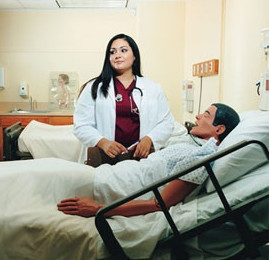
After Maine, I ended up covering a clinic in Ft. Lauderdale, FL for one week. The physician is a family friend and he asked me to let him know when I was available to provide coverage for one week, so that he could go on vacation. This way he wouldn’t have to close down his clinic, and there would be a provider present to see patients and provide medication refills etc.
Since we wouldn’t be going through an agency (lucky him), I charged him a higher hourly rate than I usually am paid through the agency. At first, he was looking to pay a lower rate than I was charging. He only wanted to pay $60/hour which is what permanent nurse practitioners make in the area.
However, I told him through an agency he would normally have to pay double that, since they are filling a demand and it is pretty costly. I was only charging him $90/h since we weren’t going through an agency, but realistically there is a premium for locum nurse practitioners. This is because I can easily learn the EHR (electronic health record) they are using in a matter of minutes and wouldn’t need a thorough orientation to provide coverage for one week. A non-locums provider, wouldn’t be able to jump into a new environment and start seeing patients within the first hour, as I am.
Eventually he agreed to my rate and I made sure to draft up a contract which stated the requested dates and hours to be worked, and the hourly pay. I also made sure that he added me onto his malpractice coverage. Since I wasn’t going through an agency, I had to be sure I was protecting myself – family friend or not.
Covering his clinic was pretty straight forward. His practice used Practice Fusion EHR which I was familiar with. The patient load was fair, about 12-15 patients per day. The majority of the patient population were Haitian, so it was fun practicing my Haitian Creole and French.
I realized how different the Haitian population is in comparison to their neighboring Hispanics. Hispanic patients typically come with a list of complaints and want to take as many medications as possible. Haitian patients seemed to be more shy and won’t tell you if something is bothering them unless you ask them directly. They aren’t interested in taking medications or even accepting that they are “sick”. This can be a bad thing because it seemed that a lot of them had complex chronic illnesses that could have been treated better early on, had the patient been compliant or honest.
I had forgotten how South Florida clinics sometimes run on Caribbean time. Meaning, patients often showed up 30-45 minutes late to their appointment but were still expected to be seen (by both staff and patient). In addition, they didn’t mind waiting an hour to be seen by the provider. Obviously, in more Americanized clinics, patients are considered no shows if they are more than 10 minutes late. And it’s all about lowering “wait times”.
I had a good experience covering the clinic for one week. I was a bit nervous at first since it was the first time I was doing this without the help or guidance of an agency. But everything worked out well. I suppose my 4 years of being a traveling nurse practitioner paid off.
My only issue was after completing the assignment, the physician of the clinic provided me with some unnecessary feedback. It was mostly just nit picking of my documentation. He told me I should describe how my patients look better (such as tall, obese, Caucasian, black). He said if a patient is anemic I should specify mild or severe (even though I listed the hemoglobin level under the diagnosis).
I tried not to let this feedback bother me because he clearly has never had a locums before. Everyone documents differently, and I consider myself to document thoroughly considering I have a nursing background. But of course, every provider has their own way of documenting and he can’t expect everyone to do it the way he wants it to be done.
Had his feedback been specific to patient management, such as “perhaps use this medication next time” or “refer this patient for a cardiology evaluation”, that would have been a different story. I welcome any criticism when it is beneficial.
Anyways, I just wanted to share my story providing coverage on my own. Maybe once you have enough experience as a traveling nurse practitioner, you can start providing coverage on your own too. Keep in mind, I didn’t need any housing or travel since the clinic was in my home area. So, there are definitely some benefits to working through an agency versus on your own, but that comes at a cost. Those benefits include completing credentialing, facilitating orientation, arranging and covering housing and travel, providing liability insurance etc. The main benefit of working without an agency will be increased pay.
Like this:
Like Loading...















